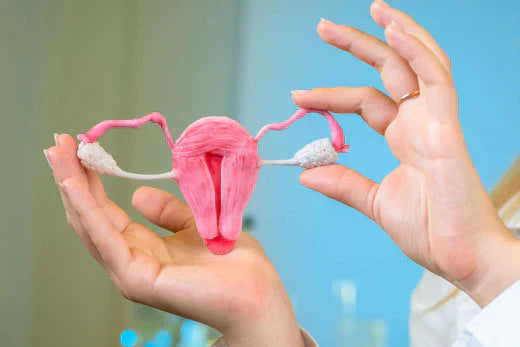Perhaps you have reached the stage of perimenopause and are aware of the multiple changes in your menstrual cycles. But instead of less bleeding, have heavy menstrual bleeding?
- We want to accompany you in the challenges of this new stage. That's why we explain everything you need to know about this change and how to deal with it.
What is heavy menstrual bleeding?
All women have different cycles. Cycles can range in length from 21 to 35 days and can last from 2 to 7 days. With estimated loss of less than 80 ml considered normal, anything above this is considered heavy (Mayo Clinic, 2019). Its medical term is menorrhagia. However, any bleeding beyond what is known as "normal" for the individual is considered an issue (Santoro & Clain, 2021; CDC, 2018).
Symptoms of heavy menstrual bleeding
The symptoms are very varied, the person can (Mayo Clinic, 2021):
- Soak one or more pads in an hour, for several consecutive hours.
- Need to use double pads.
- Must change pads during the night.
- Having a period that lasts more than a week.
- Passing clots the size of a coin.
- Brown discharge between periods.
- Limiting normal activities.
- Anemia, dizziness, shortness of breath.
Causes of heavy menstrual bleeding
Causes vary according to a woman's age and stages of fertility. The main ones are (Mayo Clinic, 2021):
- Hormonal imbalance: such as polycystic ovary syndrome, obesity, insulin resistance, thyroid problems, and perimenopause.
- Ovarian dysfunction.
- Uterine tumors.
- Myomatosis.
- Intrauterine device for contraception (copper T).
- Cancer of the cervix.
- Blood clotting problems.
- Medications to reduce clotting or pain, and contraceptives.
- Kidney and liver disease.
Why heavy menstrual bleeding occurs in perimenopause?
Menstrual cycles are governed by two hormones called oestrogen and progesterone. When these hormones decline, a woman may have an irregular menstrual cycle. During perimenopause there is a decline in these hormones (Kumar & Kumari, 2020). As they decline, they cause impaired clotting, leading to heavier and longer-lasting bleeding. Similarly, the regularity of the menstrual cycle is disturbed (Kumar & Kumari, 2020).

Treatment of heavy menstrual bleeding
Please speak to your medical professional to diagnose heavy bleeding. Once malignant diseases have been ruled out, treatment should be initiated. Always seek specialist medical advice. Never self-medicate. The main measures are (CDC, 2018; Mayo Clinic, 2021):
- Iron supplementation, especially in cases of anemia.
- Medication for pain and inflammation.
- Tranexamic acid: used to decrease bleeding in some cases, only use under medical indication.
- Oral contraceptives and hormonal IUDs: used to replace hormones that are diminished at this stage.
- In severe cases, when medical treatment does not work, surgical procedures should be performed. Such as curettage or even total removal of the uterus.
Complications of heavy menstrual bleeding
Continuous loss of large amounts of blood can lead to anemia. This occurs when the body wants to compensate for this loss and the iron stores are depleted. Furthermore, it causes difficulty in transporting oxygen to the various organs of the body. As a result, patients may present paleness, weakness, and fatigue (Mayo Clinic, 2021). Additionally, intense pain known as dysmenorrhea can occur. Sometimes this can be so severe that it needs to be checked by a doctor (Mayo Clinic, 2021). In some cases, abnormal uterine bleeding is the first symptom of clotting disorders. These include von Willebrand disease and immune thrombocytopenia. Both can lead to bleeding in other regions of the body, with fatal outcomes (Jaramillo et al., 2019; Sánchez et al., 2021).
When to see a doctor
The main and most serious complication is shock. It occurs when too much blood has been lost and there is inadequate blood supply to vital organs. There is drowsiness, cold and clammy skin, palpitations, no urine, high blood pressure. It can have life-threatening complications (Procter, 2019; Moake, 2020). If pregnancy is likely, it should be ruled out immediately. It may be a miscarriage or ectopic pregnancy. All in all, heavy menstrual bleeding is a fairly common problem, especially during the perimenopause. However, the issue should not be overlooked. Because it can lead to serious complications. If you experience any symptoms, we recommend that you see your doctor and never self-medicate.
References:
-
Centro para el Control y la Prevención de Enfermedades
. (2018). Sangrado menstrual abundante. https://www.cdc.gov/ncbddd/spanish/blooddisorders/women/menorrhagia.html - Jaramillo, L.; Martínez, L., y Tabares, M. D. (2019). El papel de la enfermedad de von Willebrand en la hemorragia uterina anormal. Revista Cubana de Obstetricia y Ginecología, 45(4), 405. https://www.medigraphic.com/pdfs/revcubobsgin/cog-2019/cog194i.pdf
- Kumar, R., & Kumari, A. (2020). Abnormal uterine bleeding in peri-menopausal age: An observational study. Indian Journal of Obstetrics and Gynecology Research, 5(4), 539–543. https://doi.org/10.18231/2394-2754.2018.0121
- Mayo Clinic. (2019). Ciclo menstrual: qué es normal y qué no. https://www.mayoclinic.org/es-es/healthy-lifestyle/womens-health/in-depth/menstrual-cycle/art-20047186
- Mayo Clinic. (2021). Menorragia (sangrado menstrual intenso). https://www.mayoclinic.org/es-es/diseases-conditions/menorrhagia/symptoms-causes/syc-20352829
- Moake, J. (2020). Hemorragia excesiva. Manual MSD Versión Para Profesionales; Manuales MSD. https://www.msdmanuals.com/es/professional/hematolog%C3%ADa-y-oncolog%C3%ADa/hemostasia/hemorragia-excesiva
- Procter, L. (2019). Choque (shock). Manual MSD Versión Para Público General; Manuales MSD. https://www.msdmanuals.com/es/hogar/trastornos-del-coraz%C3%B3n-y-los-vasos-sangu%C3%ADneos/presi%C3%B3n-arterial-baja-y-choque-shock/choque-shock
- Sánchez, T., Delgado, K., Zambrano, L., & Robles, M. (2021). Complicaciones hemorrágicas asociada a trombocitopenia inmunológica: características clínicas. Journal of American Health. https://jah-journal.com/index.php/jah/article/view/86
- Santoro, N., & Clain, E. (2021). Sangrado uterino anormal en la perimenopausia. Contemporary OB/GYN. http://www.fasgo.org.ar/images/Sangrado_uterino_anormal_en_la_perimenopausia.pdf
You May Also Like

JOIN US AND GET 10% OFF
Sign up to our newsletter to access free resources, advice and support.















